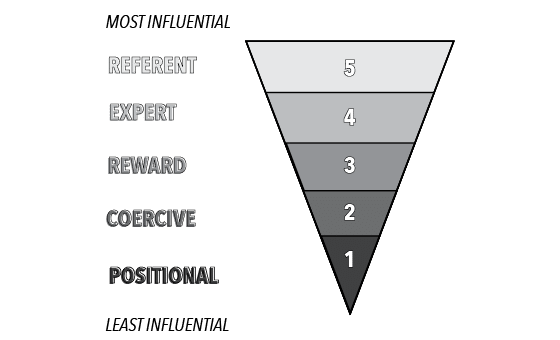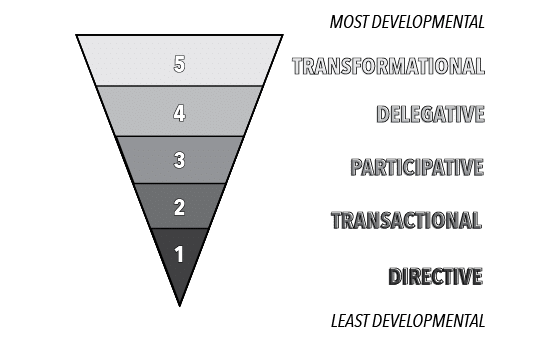5 Levels of Leadership & Influence
Leadership Styles:
Resourcing, empowering, and serving others is the key to leading well.
The first person we need to lead is ourselves. When we steward our own character well, the overflow will affect others. Being intentional about how we influence others while continuing to steward our own character is the crossroad of leadership.

What is leadership?
Leadership is influencing others to get THERE.
Since all of us have the ability to influence one another, anyone can be a leader. Regardless of whether we hold official roles, the way we steward our influence is the heart of leadership.
How we lead
There are five leadership styles. We can leverage each to influence individuals in our organization towards our Transcendent THERE.
1. Directive
- Leaders assign the THP to others, dictating where we’re going and how we’re going to get there.
- Directive leadership is the least effective way to develop others, since it’s based mostly on positional influence.
- Directive leadership places individuals low on the Freedom V.
- You should use directive leadership when individuals:
- Are new to the organization.
- Are new to the position/role.
- Or have been moved down the Freedom V.
2. Transactional
- Leaders motivate others with positive and negative consequences. In other words, if you do this, you’ll get a reward. If you don’t, you’ll be disciplined.
- This type of leadership is based mostly on positional, reward, and coercive influence.
- In the short term, transactional leadership can teach boundaries and consequences, helping people develop good habits.
- This style is used when individuals are low on the Freedom V.
- Transactional Leadership benefits individuals who:
- Are grappling to understand or accept the vision.
- Need reinforcement for meeting (or failing to meet) expectations/boundaries.
3. Participative
- Leaders show others the THP, participating in some capacity to empower and guide them towards the THERE.
- This style relies mostly on Expert Influence and is very effective for teaching and mentoring.
- Participative leadership encourages greater levels of proficiency and ownership. It helps move individuals higher up the Freedom V.
4. Delegative
- Leaders assign a goal (THERE) to an individual. However, they do not also assign the PATH. Instead, they delegate the “how” to the individual.
- While leaders can delegate responsibilities, they cannot delegate their authority. Leaders must make sure that they still have systems and checks to make sure the project is getting done.
- Delegative Leadership works best for those who:
- Have demonstrated a level of proficiency within their roles.
- Are committed to the THERE.
5. Transformational
- Leaders share and actively participate in THP process. They model THP, seek and share truth, and empower self-governance.
- Leaders participate in the THP alongside those they’re leading. Instead of modeling desired behavior and then leaving, transformational leaders co-labor with those they’re leading.
- The leaders is consistently active and empowering others to take up their part alongside him or her.
- Transformational leadership leans heavily on Referent Power. Individuals who are led this way tend to be high on the Freedom V, understanding expectations and creating their own boundaries within those expectations.
- Transformational Leadership benefits those who:
- Have demonstrated commitment to THP.
- Are capable/willing to take ownership in their share of the mission.
Which style of leadership do you feel most comfortable in? Which does your role (at home or work) require of you? What is the goal of leadership? In what areas do you see opportunities to grow in your own leadership journey?
Types of Influence:
We cannot control others, but we are all influencing others every day.
This model explores the diverse ways people influence one another, from obligation to inspiration, impersonal to shared endeavor. It challenges us to first lead ourselves and then lead others.

This model explores the diverse ways people influence one another, from obligation to inspiration, impersonal to shared endeavor. It challenges us to first lead ourselves and then lead others.
What’s the difference between influence and control?
Influence means empowering, encouraging, and equipping others to take ownership of their character, commitment, and vision.
On the other hand, control means trying to force others to adhere to your vision, validate your personality, and take some weight from your load of ownership.
Healthy leaders realize they cannot control others but have the opportunity to influence them. They invite others to partner in working towards something bigger than themselves. This leads to a shared vision, co-ownership of the mission, and an effective culture of self-governance.
The five types of influence
1. Positional Influence: This is influence based on a title, job, or position. You gain positional influence when you are placed in positions of authority. The position you hold carries a perceived weight that allows you to influence the thoughts, actions, and perceptions of others. This is the most sought after but least effective way to influence others.
Examples: a police officer, teacher, parent or coach.
2. Coercive Influence: This kind of influence comes from the perception that someone has the ability to punish you or enact negative consequences. You gain coercive influence by following through on disciplinary threats and reinforcing established boundaries.
Examples: Discipline from a parent, anger from a spouse, ridicule from a friend, or demotion from a manager.
3. Reward Influence: This is the opposite of coercive influence. It comes from the perception that someone has the ability to reward you if you do, think, or say what they are asking. When you follow through on the promise of reward, you gain reward influence. When you don’t follow through, you lose it.
Examples: Teammates applaud performance on the field, a teacher gives out snacks or prizes when a student answers correctly, a boss gives a raise to an employee for doing a good job, and parents extend the child’s curfew when the child stewards responsibility well.
4. Expert Influence: This comes from demonstrating a level of expertise in a specific area. You gain expert influence by demonstrating proficiency; you lose expert influence by pretending to know answers when you don’t know them or providing false/inadequate information on a topic.
Examples: A professor who has studied and published in their fields, an experienced skateboarder who knows more tricks than a novice, or a married person giving relationship advice to a single (or newlywed) friend.
5. Referent Influence: This type of influence comes from doing life in a way others want to emulate, by stewarding one’s own character. You gain referent influence through strengthening your Pillars; you lose it when you demonstrate poor character or choices.
Examples: A personal hero–mom, dad, a mentor, a coach or historical figures renowned for service, courage, and character– Ghandi, Mother Teresa, or Abraham Lincoln.
The rules of referent power
How do you cultivate referent influence? Gaining referent power is about both becoming the best person you can be and leading others effectively. The tenets of referent power show us the key areas of life on which we should focus to best steward our lives.
Referent influence is based around several “pillars.” When you steward these pillars well, people will want to emulate you. The result of stewarding these pillars is that they will be strong––healthy and true, not superficial.
For example, if your emotional pillar is strong, it doesn’t mean that you’re never sad or angry, it means that you are someone who stewards those emotions well.
True vulnerability is stronger than false masking.
The stronger any one of your pillars is, the greater level of influence you can exercise in that area. Conversely, the weaker a pillar is, the less influence you’ll be able to exercise.
We strengthen our pillars by investing time and energy into them.
The six tenets of referent power
1. Physical: How someone presents themselves, physical appearance and presence.
Can Be Strengthened Through:
- Healthy diet
- Exercise
- Proper hygiene
- Appropriate manner of dress
Can be weakened through:
- Unhealthy diet
- Lack of exercise
- Improper hygiene
- Inappropriate manner of dress
2. Financial: How an individual stewards their finances.
Can Be Strengthened Through:
-
- Investments
- Savings
- Generous giving
- Budgeting
Can be weakened through:
-
-
- Debt
- Worship of money
- Fear of money
- Poor spending habits
-
3. Social: A person’s ability to interact with others relationally.
Can Be Strengthened Through:
-
-
- Curiosity/Asking questions
- Listening
- Appropriate sense of humor
- Ability to have deep conversations
-
Can be weakened through:
-
-
- Lack of curiosity
- Self-centeredness
- Inability to share and/or accept truth
- Taking oneself too seriously
-
4. Spiritual: A person’s relationship with God, trust and commitment to something bigger than themselves.
Can Be Stengthened Through:
-
-
- Practicing spiritual disciplines
- Actively participating in community
- Serving others
- Sharing true perspective
-
Can be weakened through:
-
-
- Lack of spiritual disciplines
- Isolation
- Exclusion
- Pride
-
5. Mental/Emotional: An individual’s mental and emotional intelligence.
Can Be Strengthened Through:
-
-
- Reading/Studying
- Listening to others
- Actively seeking truth
-
Can be weakened through:
-
-
- Complacency
- Assuming superiority
- Inappropriate emotional boundaries
-
6. Family/Team: An individual’s ability to connect and work with others.
Can Be Strengthened Through:
-
-
- Kindness/Compassion
- Courage
- Vulnerability
-
Can be weakened through:
-
- Selfishness/pride
- Apathy/Complacency
- Competing against instead of with Team

